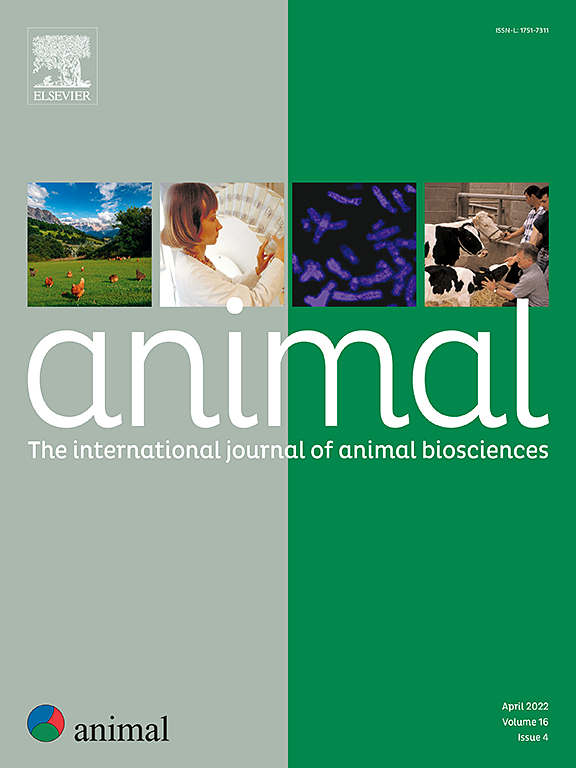过量喂养母母骡鸭正常肝和静脉肝脂肪变性的发展
IF 4
2区 农林科学
Q1 AGRICULTURE, DAIRY & ANIMAL SCIENCE
引用次数: 0
摘要
在最近的各种禽流感危机之后,雄性骡子鸭的短缺导致使用雌性骡子鸭,尽管通常不使用雌性骡子鸭,主要是因为最终产品的外观存在缺陷。本研究的目的是研究在瘦肝或脂肪肝表面有或没有可见静脉网络的雌性骡鸭中,过度喂养引起的肝脏脂肪变性的演变。肝脂肪变性的总体演变(体重增加,总生化组成)在两种类型的肝脏中惊人地相似。组织学观察证实,在这两种类型的肝脏中,在整个过度喂养期间,肝细胞中脂滴的积累稳步增加。同时,其他参数(纤维发生,通过羟脯氨酸的积累来测量;氧化状态,通过超氧化物歧化酶和过氧化氢酶的活性来测定;还原性和氧化性谷胱甘肽的含量以及缺氧水平(用缺氧1和缺氧2诱导因子测量)在所有样品中也发生了类似的变化。当比较正常肝脏和静脉性肝脏时,属于不同代谢途径的基因的总体活性也没有显示出任何重大差异。由此可见,母母骡鸭正常肝和静脉肝在过度饲养诱导下发生脂肪变性的条件非常相似。然而,这些可见的解剖差异降低了最终产品的视觉质量,使静脉肝对加工者和消费者的吸引力降低。本文章由计算机程序翻译,如有差异,请以英文原文为准。
Development of hepatic steatosis in normal and veinous livers of overfed female mule ducks
Following the various recent avian influenza crises, the shortage of male mule ducklings has led to the use of females, although these are not normally used mainly because of defects in the presentation of the final product. The aim of this study was to examine the evolution of hepatic steatosis induced by overfeeding in female mule ducks with or without a visible network of veins on the surface of lean or fatty livers. The overall evolution of hepatic steatosis (weight gain, gross biochemical composition) was strikingly similar in both types of liver. Histological observations confirm that in both types of livers, there is a steady increase in the accumulation of lipid droplets in hepatocytes throughout the period of overfeeding. At the same time, other parameters (fibrogenesis, measured by the accumulation of hydroxyproline; oxidative status, measured by the activities of the enzymes superoxide dismutase and catalase; contents of reduced and oxidised glutathione and level of hypoxia, measured with Hypoxia 1 and 2 Induced Factors) are also altered similarly in all samples. Nor did the overall activities of genes belonging to different metabolic pathways reveal any major differences when normal and veinous livers were compared. In conclusion, hepatic steatosis induced by overfeeding developed under very similar conditions in the normal and veinous livers of female mule ducks. However, these visible anatomical differences degrade the visual quality of the final product and make veinous livers less attractive to processors and consumers.
求助全文
通过发布文献求助,成功后即可免费获取论文全文。
去求助
来源期刊

Animal
农林科学-奶制品与动物科学
CiteScore
7.50
自引率
2.80%
发文量
246
审稿时长
3 months
期刊介绍:
Editorial board
animal attracts the best research in animal biology and animal systems from across the spectrum of the agricultural, biomedical, and environmental sciences. It is the central element in an exciting collaboration between the British Society of Animal Science (BSAS), Institut National de la Recherche Agronomique (INRA) and the European Federation of Animal Science (EAAP) and represents a merging of three scientific journals: Animal Science; Animal Research; Reproduction, Nutrition, Development. animal publishes original cutting-edge research, ''hot'' topics and horizon-scanning reviews on animal-related aspects of the life sciences at the molecular, cellular, organ, whole animal and production system levels. The main subject areas include: breeding and genetics; nutrition; physiology and functional biology of systems; behaviour, health and welfare; farming systems, environmental impact and climate change; product quality, human health and well-being. Animal models and papers dealing with the integration of research between these topics and their impact on the environment and people are particularly welcome.
 求助内容:
求助内容: 应助结果提醒方式:
应助结果提醒方式:


